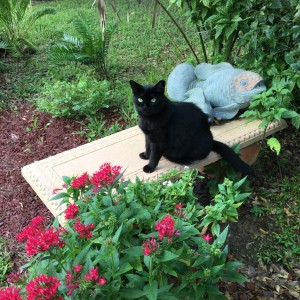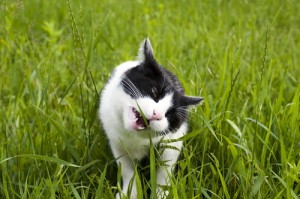 Dewey, our black cat, occasionally eats tender blades of grass that grow in our garden beds around the house. It became a realization several years ago that I must stop my chemical warfare of combating the errant weeds to protect our (and Dewey’s) good digestive bacteria. Yes, we have more weeds since I am no longer recklessly squirting Roundup; but I know Dewey is eating more organic when she goes for an outdoor picnic. My husband and I, however, will never understand Dewey’s cat nature of chasing and tackling lizards and frogs that co-habitat in and around our Florida lanai. Their own innate toxins temporarily cause Dewey’s vocal cords to make croaky sounds – at least those small critters visiting our gardens are also GMO free.
Dewey, our black cat, occasionally eats tender blades of grass that grow in our garden beds around the house. It became a realization several years ago that I must stop my chemical warfare of combating the errant weeds to protect our (and Dewey’s) good digestive bacteria. Yes, we have more weeds since I am no longer recklessly squirting Roundup; but I know Dewey is eating more organic when she goes for an outdoor picnic. My husband and I, however, will never understand Dewey’s cat nature of chasing and tackling lizards and frogs that co-habitat in and around our Florida lanai. Their own innate toxins temporarily cause Dewey’s vocal cords to make croaky sounds – at least those small critters visiting our gardens are also GMO free.
Brief History of GMO
Polls regularly show that the overwhelming majority of American consumers want to know whether their food is genetically engineered. There is on-going controversy over the evolution of federal and state regulations that would govern “clean” labels such that manufacturers must disclose any GMO (Genetically Modified Organisms) contamination in their products. This may include the use of glyphosate (a weed killer), and one of the active ingredients of Monsanto’s Roundup, which is widely sprayed in food crop fields.
 During a free webinar*, Dr. Zachary Bush, M.D. gives an interesting timeline beginning around the end of World War II, on the history of commercial food production in the United States and loss of essential peptides and other micronutrients in soil to grow nutrient-dense food. Consequently, Dr. Zach says the weakened food crops became more susceptible to diseases and man-made “Bandaids” such as the weed killer glyphosate (which ties up the nutrients of plants so they die) that came on the market prior to the 1980s. Mega farms with more annual plant cycles became a realty when Monsanto introduced GMO (“Roundup Ready”) seeds for farmers to grow crops that can withstand glyphosate, supposedly only killing the weeds, in the 1990s. Also, glyphosate is used as a desiccant to dry out the harvested crop such as wheat, and start another planting cycle faster.
During a free webinar*, Dr. Zachary Bush, M.D. gives an interesting timeline beginning around the end of World War II, on the history of commercial food production in the United States and loss of essential peptides and other micronutrients in soil to grow nutrient-dense food. Consequently, Dr. Zach says the weakened food crops became more susceptible to diseases and man-made “Bandaids” such as the weed killer glyphosate (which ties up the nutrients of plants so they die) that came on the market prior to the 1980s. Mega farms with more annual plant cycles became a realty when Monsanto introduced GMO (“Roundup Ready”) seeds for farmers to grow crops that can withstand glyphosate, supposedly only killing the weeds, in the 1990s. Also, glyphosate is used as a desiccant to dry out the harvested crop such as wheat, and start another planting cycle faster.
Unfortunately, the good intentions of producing more food may have led to soils with less diverse bacteria populations and micronutrients. Food tainted with glyphosate might have contributed to a lower diversity of our own gastrointestinal bacteria since World War II, when backyard Victory Gardens were more prevalent.
More Backyard Thoughts
Our non-GMO Victory Garden has more weeds that need to be hand pulled. Along with mulching, I am experimenting with placing a doormat on top of a patch of weeds, which smothers them after several days and makes them easier to pull. Dewey likes this new weed control technique since it gives her another place to lounge during her cat naps.
What is your idea in creating a safer eco-friendly garden? Please send us an email to inquiries@aquanew.com so we can share with others.
* Interview of Dr. Zachary Bush, M.D. by Harmony Restored, dated June 3, 2016, http://www.harmony-restored.com/gut-health and https://www.facebook.com/restore4life (This free webinar requires registration with Harmony Restored for access.)
** Top Photo: Dewey Enjoying her Non-GMO Victory Garden
